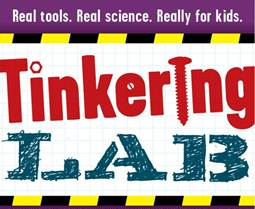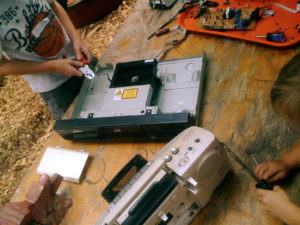Mechanics
 PROJECT: Disassemble old appliances and toys, and classify their parts as one of six simple machines
PROJECT: Disassemble old appliances and toys, and classify their parts as one of six simple machines
GOAL: To learn the basics of physics and how they differ in form and function
The six simple machines have been part of the civilized world for a long time, but if you need a refresher course on them, you can turn for help to two books written for readers of all ages: MACHINES AND HOW THEY WORK by Harvey Weiss (Sterling Publications) and THE NEW WAY THINGS WORK by David Macaulay (Houghton Mifflin).
Before your kids roll up their sleeves and start unscrewing, your job is to visually represent each of the six simple machines around the edge of a sheet of light-colored poster board. If you’re not good at drawing, you may want to photocopy pictures of each machine, cut them out and glue them to the paper. The diagram you create can be used over and over again. You also might want to stick with machines that are fairly uncomplicated. We found that blenders and windup toys were easy to take apart and separate into pieces. While an old bike will provide tons of simple machines, electronic devices don’t have many of the basic components.
Sheet of light-colored poster board
Broken appliances or toys
Phillips screwdriver
Standard screwdriver
Hammer
With the poster board as a working surface, let your children use the tools to take apart a toy or appliance. As they come across a new part, ask them to place it near the appropriate illustration. Anytime they’re stumped about something encourage them to talk it out with their friends. Make sure you consider the function of the part as well as its shape. If your kids get into this project, check out a book of Rube Goldberg’s drawings from the library. RUBE GOLDBERG: INVENTIONS by Maynard Frank Wolfe (Simon & Schuster) is a good one. Goldberg designed all kinds of wacky inventions by stringing together simple machines in unlikely combinations. One I particularly liked was a contraption that quiets the baby in the middle of the night. Campbell caps off the lesson by asking students to draw a Goldberg-like invention using three simple machines. Your children might enjoy designing an invention of their own.
THE SIX TYPES OF MACHINES
1. THE LEVER A rod that tilts on a pivot, or fulcrum, to produce a useful action at another point. Examples: pliers, seesaw, wheelbarrow, nail clippers, tweezers.
2. THE INCLINED PLANE A sloping surface; it reduces the effort needed to raise loads. Example: ramp.
3. THE SCREW A shaft with a thread or groove. The screw holds things together by turning and moving into surrounding material. Some gears work with a screwlike motion. Examples: boat propellers and corkscrews.
4. THE WHEEL AND AXLE A device that turns around a fixed point to act as a rotating lever. Examples: steering wheel, faucet, wrench tightening a bolt, bike wheels, water wheel.
5. THE PULLEY A grooved wheel that turns on an axle over which a rope, chain or belt passes. The groove fixes the rope or cable so that it won’t slip off. Examples of pulleys in action: stage curtain, elevator, outdoor clothesline.
6. THE WEDGE A part of a machine with a sloping side that moves to exert force. It differs from the inclined plane by its function: the wedge forces itself between other parts. Nearly all cutting machines make use of the wedge. Examples: scissors (blades act as paired wedges), door wedge, ax, wood chisel.








